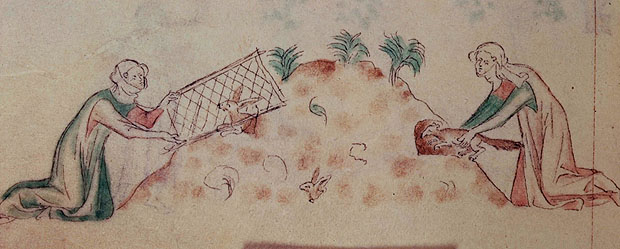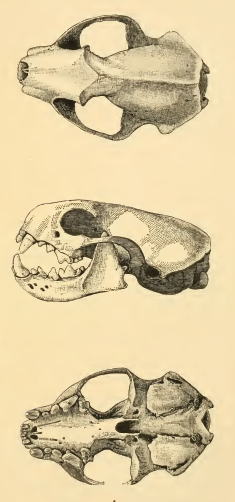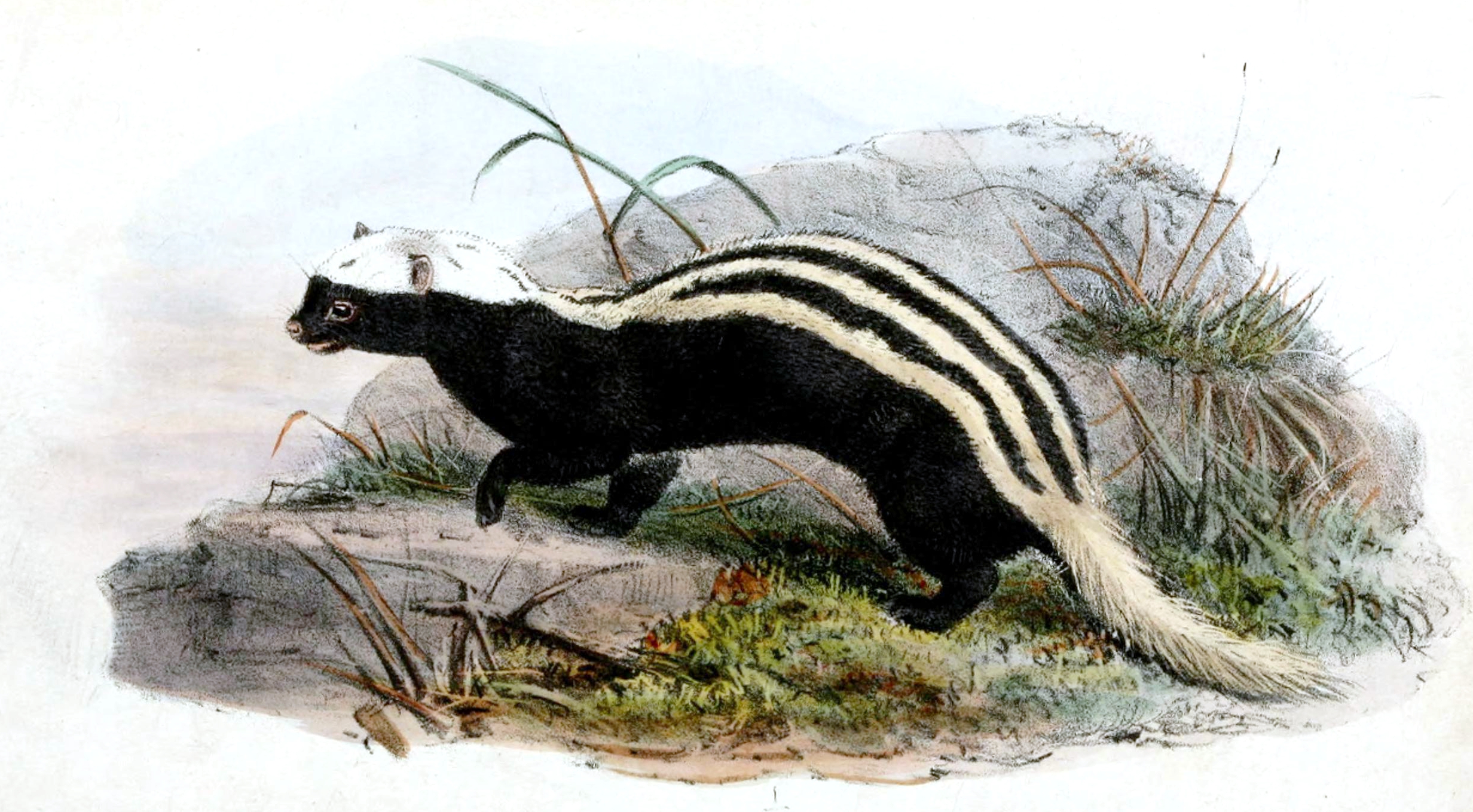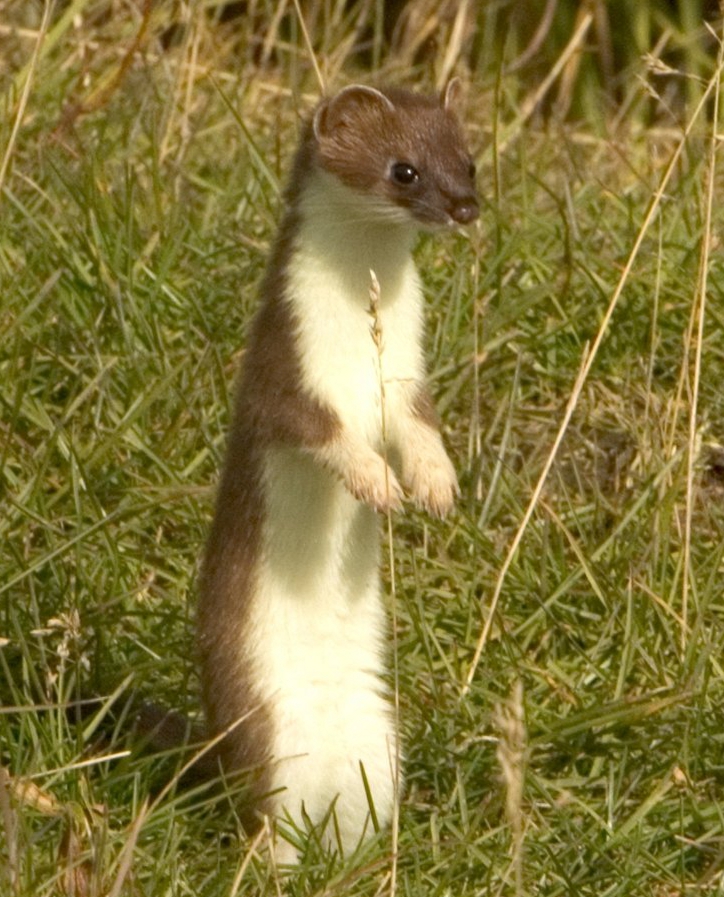|
Polecat
Polecat is a common name for several mustelid species in the order Carnivora and subfamilies Ictonychinae and Mustelinae. Polecats do not form a single taxonomic rank (i.e. clade). The name is applied to several species with broad similarities to European polecats, such as having a dark mask-like marking across the face. In the United States, the term ''polecat'' is sometimes applied to the black-footed ferret, a native member of the Mustelinae. In Southern United States dialect, the term ''polecat'' is sometimes used as a colloquial nickname for the skunk, which is part of the family Mephitidae. Despite their common name, polecats are related more closely to dogs than to cats. Taxonomy According to the most recent taxonomic scheme proposing eight subfamilies within Mustelidae, polecats are classified as: Subfamily Ictonychinae *Genus '' Ictonyx'' ** Striped polecat, ''I. striatus'', (native to Central, Southern, and sub-Saharan Africa) ** Saharan striped polecat, ''I. liby ... [...More Info...] [...Related Items...] OR: [Wikipedia] [Google] [Baidu] |
European Polecat
The European polecat (''Mustela putorius''), also known as the common polecat, black polecat and forest polecat, is a mustelid species native to Europe, Western Asia and North Africa. It is of a generally dark brown colour, with a pale underbelly and a dark mask across the face. Occasionally, colour mutations including albinos, leucists, isabellinists, xanthochromists, amelanists, and erythrists occur. It has a shorter, more compact body than other '' Mustela'' species, a more powerfully built skull and dentition, is less agile, and is well known for having the characteristic ability to secrete a particularly foul-smelling liquid to mark its territory. It is much less territorial than other mustelids, with animals of the same sex frequently sharing home ranges. Like other mustelids, the European polecat is polygamous, with pregnancy occurring after mating, following induced ovulation. It usually gives birth in early summer to litters consisting of five to ten kits, which ... [...More Info...] [...Related Items...] OR: [Wikipedia] [Google] [Baidu] |
Striped Polecat
The striped polecat (''Ictonyx striatus''), also called the African polecat, zoril, zorille, zorilla, African muishond, striped muishond, Cape polecat, and African skunk, is a species of mammal native to sub-Saharan Africa. Despite bearing some resemblance to a skunk (of the family Mephitidae), it actually belongs in a separate family known as the Mustelidae, and genetic analysis suggests that its closest living relative is the African striped weasel. Historically, this species has been wrongly classified as a type of skunk or sloth. It is adaptable and lives in a wide range of habitats and elevations, with a preference for open environments that have lower levels of shrubs, especially ones where large ungulates are present to control shrub growth. It avoids dense rainforests and deserts with no scrub cover, thus being absent from the Congo Basin, the more coastal areas of West Africa, and the driest parts of Somalia and Ethiopia. Measuring in length excluding the tail, the str ... [...More Info...] [...Related Items...] OR: [Wikipedia] [Google] [Baidu] |
Saharan Striped Polecat
The Saharan striped polecat (''Ictonyx libycus''), also known as Saharan striped weasel and Libyan striped weasel, is a species of mammal native to northern Africa. It belongs in the family Mustelidae, and debate exists among experts over what genus it belongs to; it is either placed in '' Ictonyx'' along with the striped polecat, or as the lone member of a separate genus called ''Poecilictis''. Genetic analysis has shown that its closest living relatives are the striped polecat and African striped weasel. It mainly inhabits dry, steppe-like environments with sparse bush cover along the edges of the Sahara Desert and on its mountains, avoiding the most arid regions in its center. Occasionally, it is found in oases, woodlands and cultivated land. As a secretive animal, it has likely been overlooked in parts of its range, and sightings of it are still made in recent years in locations where it has not been recorded before. Measuring in length excluding the tail, this species is a ... [...More Info...] [...Related Items...] OR: [Wikipedia] [Google] [Baidu] |
Steppe Polecat
The steppe polecat (''Mustela eversmanii''), also known as the white or masked polecat, is a species of mustelid native to Central and Eastern Europe and Central and East Asia.It is listed as Least Concern on the IUCN Red List because of its wide distribution, occurrence in a number of protected areas, and tolerance to some degree of habitat modification. It is generally of a very light yellowish colour, with dark limbs and a dark mask across the face. Compared to its relative, the European polecat, the steppe polecat is larger in size and has a more powerfully built skull. The steppe polecat is a nomadic animal which typically only settles in one area until its prey, mainly ground squirrels, are extirpated. It mates from March to May, and generally gives birth to litters of three to six kits, which attain their full growth at the age of two years. It hunts for larger prey than the European polecat, including pikas and marmots. Evolution The earliest true polecat was '' Must ... [...More Info...] [...Related Items...] OR: [Wikipedia] [Google] [Baidu] |
Marbled Polecat
The marbled polecat (''Vormela peregusna'') is a small mammal belonging to the genus ''Vormela'' within the mustelid subfamily Ictonychinae. ''Vormela'' is from the German language, German word , which means "little worm". The specific name (zoology), specific name ''peregusna'' comes from (), which is Ukrainian language, Ukrainian for "polecat". Marbled polecats are generally found in the drier areas and grasslands of southeastern Europe to western China. Like other members of the Ictonychinae, it can emit a strong-smelling secretion from anal sacs under the tail when threatened. Description Ranging in length from 29–35 cm (head and body), the marbled polecat has a short muzzle and very large, noticeable ears. The limbs are short and claws are long and strong. While the tail is long, with long hair, the overall pelage is short. Black and white mark the face, with a black stripe across the eyes and white markings around the mouth. Dorsally, the pelage is yellow and he ... [...More Info...] [...Related Items...] OR: [Wikipedia] [Google] [Baidu] |
Black-footed Ferret
The black-footed ferret (''Mustela nigripes''), also known as the American polecatHeptner, V. G. (Vladimir Georgievich); Nasimovich, A. A; Bannikov, Andrei Grigorovich; Hoffmann, Robert S. (2001)''Mammals of the Soviet Union''Volume: v. 2, pt. 1b. Washington, D.C. : Smithsonian Institution Libraries and National Science Foundation. or prairie dog hunter, is a species of mustelid native to central North America. The black-footed ferret is roughly the size of a mink and is similar in appearance to the European polecat and the Asian steppe polecat. It is largely nocturnal and solitary, except when breeding or raising litters. Up to 90% of its diet is composed of prairie dogs. The species declined throughout the 20th century, primarily as a result of decreases in prairie dog populations and sylvatic plague. It was declared extinct in 1979, but a residual wild population was discovered in Meeteetse, Wyoming in 1981. A captive-breeding program launched by the United States Fish an ... [...More Info...] [...Related Items...] OR: [Wikipedia] [Google] [Baidu] |
Polecat In Denmark
Polecat is a common name for several mustelid species in the order Carnivora and subfamilies Ictonychinae and Mustelinae. Polecats do not form a single taxonomic rank (i.e. clade). The name is applied to several species with broad similarities to European polecats, such as having a dark mask-like marking across the face. In the United States, the term ''polecat'' is sometimes applied to the black-footed ferret, a native member of the Mustelinae. In Southern United States dialect, the term ''polecat'' is sometimes used as a colloquial nickname for the skunk, which is part of the family Mephitidae. Despite their common name, polecats are related more closely to dogs than to cats. Taxonomy According to the most recent taxonomic scheme proposing eight subfamilies within Mustelidae, polecats are classified as: Subfamily Ictonychinae *Genus '' Ictonyx'' **Striped polecat, ''I. striatus'', (native to Central, Southern, and sub-Saharan Africa) **Saharan striped polecat, ''I. libycus'' ... [...More Info...] [...Related Items...] OR: [Wikipedia] [Google] [Baidu] |
Poecilogale
The African striped weasel (''Poecilogale albinucha''), also known as the white-naped weasel, striped weasel or African weasel, is a small mammal native to sub-Saharan Africa, where its range stretches from as far north as Kenya down south to South Africa. It belongs in the family Mustelidae and is the lone member of the genus ''Poecilogale'', which was named in 1883 by Oldfield Thomas. It has a long, slender body with short legs and a bushy tail. One of the smallest carnivorans in Africa, it measures long excluding the tail, with males generally growing larger than females. It has black fur over most of its body, with distinctive white bands running from the top of its head down the length of its back, with the tail being completely white. Genetic analysis has revealed that the closest living relative of this species is the striped polecat, and a prehistoric animal named '' Propoecilogale bolti'' known from fossils may be the ancestor of the African striped weasel. Occurring ... [...More Info...] [...Related Items...] OR: [Wikipedia] [Google] [Baidu] |
Mustelid
The Mustelidae (; from Latin , weasel) are a diverse family of carnivoran mammals, including weasels, badgers, otters, polecats, martens, grisons, and wolverines. Otherwise known as mustelids (), they form the largest family in the suborder Caniformia of the order Carnivora with about 66 to 70 species in nine subfamilies. Variety Mustelids vary greatly in size and behaviour. The smaller variants of the least weasel can be under in length, while the giant otter of Amazonian South America can measure up to and sea otters can exceed in weight. Wolverines can crush bones as thick as the femur of a moose to get at the marrow, and have been seen attempting to drive bears away from their kills. The sea otter uses rocks to break open shellfish to eat. Martens are largely arboreal, while European badgers dig extensive tunnel networks, called setts. Only one mustelid has been domesticated; the ferret. Tayra are also kept as pets (although they require a Dangerous ... [...More Info...] [...Related Items...] OR: [Wikipedia] [Google] [Baidu] |
Mustela
Weasels are mammals of the genus ''Mustela'' of the family Mustelidae. The genus ''Mustela'' includes the least weasels, polecats, stoats, ferrets, and European mink. Members of this genus are small, active predators, with long and slender bodies and short legs. The family Mustelidae, or mustelids (which also includes badgers, otters, and wolverines), is often referred to as the "weasel family". In the UK, the term "weasel" usually refers to the smallest species, the least weasel (''M. nivalis''), the smallest carnivoran species. Least weasels vary in length from , females being smaller than the males, and usually have red or brown upper coats and white bellies; some populations of some species moult to a wholly white coat in winter. They have long, slender bodies, which enable them to follow their prey into burrows. Their tails may be from long. Weasels feed on small mammals and have from time to time been considered vermin because some species took poultry from farms ... [...More Info...] [...Related Items...] OR: [Wikipedia] [Google] [Baidu] |
Ictonychinae
Ictonychinae is a subfamily of the mammal Family (biology), family Mustelidae found mainly in the Neotropics (three species) and Africa (three species), with one Eurasian member. It includes the grisons, Patagonian weasel, Ictonyx, striped polecats, African striped weasel, and marbled polecat. These genera were formerly included within a paraphyletic definition of the mustelid subfamily Mustelinae. Most members have a mask-like bar or larger dark marking across their faces; the African representatives of the group are striped. A defense mechanism common to the group is use of a Chemical defense#Mammals, chemical spray similar to (but not necessarily as strong as) that of skunks. Species Subfamily Ictonychinae Fossil genera *''Cernictis'' *''Enhydrictis'' *''Martellictis'' *''Lutravus'' *''Oriensictis'' *''Pannonictis'' *''Propoecilogale'' *''Sminthosinis'' *''Stipanicicia'' *''Trigonictis'' *''Trochictis'' References External links Ictonychinae, {{carnivor ... [...More Info...] [...Related Items...] OR: [Wikipedia] [Google] [Baidu] |







